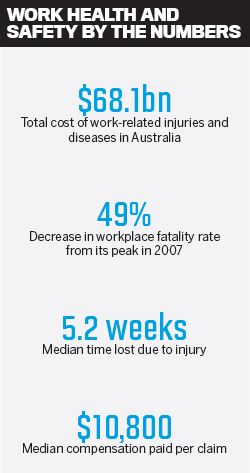

As personal injury and workers’ compensation insurance embraces new technologies, how can the industry ensure that claimants remain at the forefront? Insurance Business spoke to Gallagher Bassett’s Darrin Wright to find out
Today, almost all of our everyday activities are influenced by technology – including healthcare and personal injury management. New tools and approaches are making healthcare an easier-to-access commodity for all; the internet already enables patients to seek online consultations when and where it suits them. You can take over-the-counter tests to analyse your blood, sequence your genome and check on the bacteria in your gut. Smartphones and wearables are also allowing people to monitor their own health and engage with their community.
Healthcare is in the middle of an industrywide shift toward health and wellbeing, person-centric rehabilitation and the improvement of safety culture. In light of rising costs and ever-changing technology, there’s never been a more important time to innovate and adapt to this changing landscape. Accordingly, personal injury claims management needs to evolve in line with these new developments.
“Historically, claims management has been held back by the inability to access information, treatment or support services at an early stage,” says Darrin Wright, Executive Director of Personal Injury at Gallagher Bassett. “However, technology has gone a long way to addressing these concerns. Thanks to increased connectivity, we can improve claimant care, reduce treatment inefficiencies, and enhance rehabilitation and recovery, while also increasing employee productivity on our end.”
Though he’s a staunch advocate for the increased use of technology in the claims process, Wright is well aware that it’s also crucial for customers to still feel valued as individuals. Claimants often feel that they have a lack of knowledge and/or control over their recovery. Poor communication and inadequate engagement leave them feeling out of the loop. When handled correctly, technology can eliminate these issues – but handled poorly, it can leave claimants feeling like just another cog in the machine.
“It’s critical that technological advancement isn’t misconstrued as something that depersonalises the claims process,” Wright says. “The emphasis should always be on putting claimants at the centre of everything.”
The rise of customer-centric service
Empowered by social networks and their digital devices, consumers are increasingly dictating what they want, when and where they want it – personalised service that reflects their needs and lifestyle. This presents additional opportunities for insurers, too; as the number of sensors and other devices connected to the Internet of Things [IoT] explodes, service providers now have the opportunity to leverage data to better meet customer needs and provide a stronger value proposition. Ultimately, this should lead to a situation where customers are able to own and control their experiences, and companies are able to minimise costs, improve productivity, and increase customer satisfaction and loyalty.
In the personal injury space, providing the appropriate information, treatment and support services for claimants has always been a challenge. Service providers, schemes and practitioners need to ensure they are providing the most accurate diagnoses and advanced treatment plans, while simultaneously ensuring the claimant has easy access to everything needed for their recovery.
 “Thanks to increased connectivity, we can improve claimant care, reduce treatment inefficiencies, and enhance rehabilitation and recovery, while also increasing employee productivity on our end” - Darrin Wright, Gallagher Bassett
“Thanks to increased connectivity, we can improve claimant care, reduce treatment inefficiencies, and enhance rehabilitation and recovery, while also increasing employee productivity on our end” - Darrin Wright, Gallagher BassettTechnology has helped meet these needs: Big Data has enabled faster diagnosis, prediction capabilities and access to evidence-based treatment options for practitioners and case managers. Additionally, claimants can now access claims or treatment information via digital applications, attend online consultations with medical practitioners or use wearable devices to track and monitor their progress.
There has also been increased development and implementation of other tech solutions, such as platforms and chatbots that empower customers and reduce the need for over-the-phone interaction. And there’s been a shift from desk-bound case management for highly sensitive or complex cases to providing face-to-face service.
There have been other changes, too. Historically, the personal injury arena has had a focus on either getting the claimant back to work or, in cases where this is not possible, providing compensation in either a lump sum or on an ongoing basis.

It’s now recognised that a more holistic option is better. Rather than simply trying to speed the claimant back to work, the focus is on improving their quality of life across numerous areas, including home, the wider community and the workplace. Physical and mental wellness and recreation activities all play an important role in successful recovery.
“For example, at Gallagher Bassett, we offer a Network Support Service, which helps reconnect injured workers and their families to their community following an injury,” Wright says. “It empowers them to manage their own health and care, which results in better outcomes for everyone.”
Additionally, the burden of administration and manual tasks has a significant impact on productivity, which can have a direct impact on the wellbeing of claimants. Delayed claims can extend recovery time, exacerbate their condition and increase overall claims costs.
However, the increased use of technologies like blockchain, artificial intelligence and robotics now allows subsets or entire portions of the claims process to be automated. This not only improves worker efficiency, but also can aid in the more accurate and timely completion of tasks.
In a time of rising costs for both businesses and consumers, more companies are also realising that the best way to reduce claims is to prevent issues from occurring in the first place.
“It seems pretty obvious in hindsight,” Wright says, “but sometimes it takes a while to realise that the simplest ideas are the best.”
The integration of risk management processes, early intervention strategies, and communication campaigns that target common injuries and promote work and individual health will not only prevent injuries from occurring, but also mitigate the severity of those that do occur.
Schemes, service providers and companies have invested heavily in this space and are starting to reap the benefits. According to Safe Work Australia, the number of serious injury claims has decreased by 17.4% in the last five years.
Keeping sight of the human side
In most industries, discussion around digitalisation and the increased use of technology such as predictive analytics, robotics, automation and artificial intelligence has tended to revolve around how these tools can be used to improve and personalise the customer experience. However, Wright urges insurers not to lose sight of the human element.
“Many of these possibilities are really exciting and will probably be adopted as best practice,” he says. “But it’s important not to lose sight of the role human interaction has to play. You’re dealing with people at a sensitive time of their lives.”
In order to take advantage of the benefits of technology, the personal injury and healthcare industry needs to develop experiences that allow customers to easily move between digital and human interactions so they can get the experience and service they want. Ultimately, technology should allow companies to provide more strategic human contact and be proactive in the service they provide, enhancing – rather than replacing – the human aspect.
